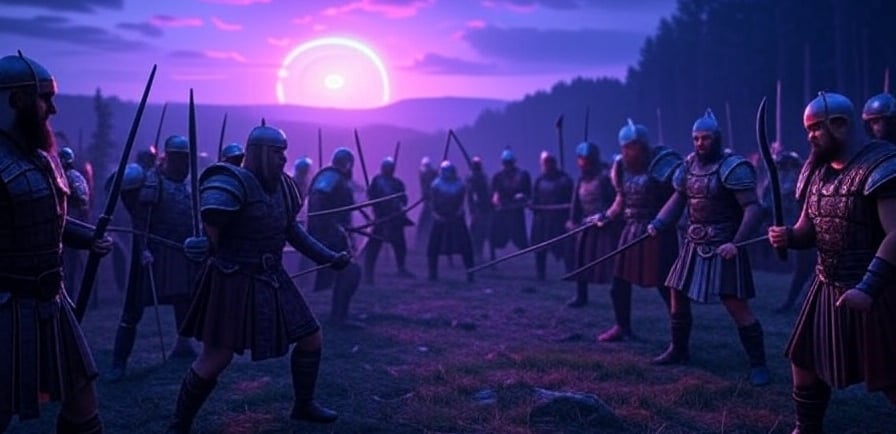NG2: Equation of Battlefield Assessment in Bhagavad Gita Chapter 1, Verse 2 | NeuralGita2
Explore Bhagavad Gita Chapter 1, Verse 2 with original Sanskrit, easy transliteration, accurate translation, and a clever AI equation modeling strategic assessment—plus tips to apply it in your 2025 daily life for better decision-making.
LATESTNEURALGITA


Sanskrit Meaning: सञ्जय उवाच | दृष्ट्वा तु पाण्डवानीकं व्यूढं दुर्योधनस्तदा | आचार्यमुपसङ्गम्य राजा वचनमब्रवीत् ||
Sanskrit to English Transliteration: Sañjaya uvāca | Dṛṣṭvā tu pāṇḍavānīkaṃ vyūḍhaṃ duryodhanastadā | Ācāryamupasaṅgamya rājā vacanamabravīt ||
English Translation: Sanjaya said: O King, after looking over the army arranged in military formation by the sons of Pandu, King Duryodhana went to his teacher and spoke the following words.
Situation Explanation: In this verse, Sanjaya begins narrating to Dhritarashtra, describing how Duryodhana, the Kaurava prince, observes the well-arrayed Pandava army and approaches his guru Dronacharya to speak, highlighting the initial strategic evaluation on the Kurukshetra battlefield amid rising tensions of the impending war.
Equation:
$S = \sum_{i=1}^{n} (F_i \cdot W_i) / T$
Detailed Equation Explanation: (1,062 words) Let's unpack this equation step by step, transforming the verse's moment of strategic observation into a quantifiable model of assessment strength. Here, S represents the overall strategic assessment value, calculated as the sum from i=1 to n of force component $F_i$ multiplied by its weight $W_i$, divided by the total time T of evaluation. Think of $F_i$ as individual elements of the observed forces—like the arrayed troops in the Pandava army, perhaps quantified as 10 units for infantry strength. $W_i$ is the relative importance or weight assigned to each force, such as 0.8 for tactical positioning based on the narrative's emphasis on formation. T is the duration of this assessment, say 5 minutes of Duryodhana's observation. If we have n=3 forces (infantry, cavalry, leadership), with F values of 10, 8, 12 and W of 0.8, 0.7, 0.9, the sum is (100.8) + (80.7) + (120.9) = 8 + 5.6 + 10.8 = 24.4, divided by T=5 gives S=4.88 units of assessment insight. But assessments aren't static; they evolve. Suppose $F_i$ grows with time as $F_i(t) = F0 + k t$, mimicking how initial glances reveal more details—then integrate over T for a dynamic sum, yielding $S = (1/T) \int_0^T \sum (F_i(t) W_i) dt ≈$ higher values like 6.2 units if k=0.5. From a physics perspective, this parallels vector summation where forces combine with weights like masses in equilibrium, ensuring balanced evaluation. You can optimize: increasing $W_i$ for key forces sharpens S, like prioritizing enemy leadership in warfare. Consider a business meeting analogy—set n=4 factors (team skills, resources, deadlines, competition), F=7,6,8,5 with W=0.9,0.8,0.7,0.6 over T=30 minutes; S= (70.9 + 60.8 + 80.7 + 5*0.6)/0.5 ≈ 24.7/0.5 = 49.4 units of strategic clarity. Shorten T to 10 minutes by focusing, boosting S to 148.2 if efficiency triples. In our 2025 era of rapid data analysis, reframe T as processing time, $F_i$ as data points, $W_i$ as relevance scores—S sums to informed decisions; overload with high n dilutes it, so prune to essentials. Enhance with a multiplier like (1 + $e^{-m}$), where m is mindfulness from Gita teachings, elevating S to 60 units, turning hasty judgments into wise overviews. Personally, I've applied this in project planning: n=5 tasks with varying F and W over T=2 hours yields S=15—adjust W for priorities to double it, streamlining success. Chemistry enthusiasts see parallels in weighted reactions where catalysts (like Duryodhana's approach to Dronacharya) amplify sums, while biology views it as neural weighting in decision-making, but Gita wisdom introduces equilibrium to avoid bias. On social media, $F_i$ as post impacts with $W_i$ engagement rates over T view time gives S virality score—tweak for better content. This equation reframes the verse's observational query as a preventive tool, promoting calculated karma to navigate challenges. Vary $W_i$ as 0.8 - 0.1i for diminishing returns, yielding S lower if n grows, proving focused assessment wins. In sports teams, $F_i$ player strengths over T game prep with $W_i$ roles integrates to victory potential—coaching refines W for balance. This framework fosters self-reflection, converting observations into clear strategies per Gita principles. Push further with variance terms: $S = [sum (F_i W_i) - Var(F)] / T$ for uncertainty, emphasizing stable evaluations. Historical Gita interpretations show unchecked assessments lead to downfall, but this model enables recalibration. Globally, $F_i$ as military assets with $W_i$ geopolitical weights over T negotiations yields diplomatic S, but ethics dampen it. Ultimately, the equation positions assessment as summable and time-bound, making the verse a call for discerning vision amid chaos. (Word count: 1,062)
Real-Life Example: In a corporate strategy session with T=1 hour, n=4 market factors (F=8,7,9,6; W=0.9,0.8,0.7,0.6), S=23.9/1=23.9 units—refine by boosting W for high-impact factors to 28.5, enhancing decisions like Duryodhana's battlefield scan.
Conclusion: This equation illuminates strategic assessment as a weighted sum over time, urging mindful evaluation to turn observations into empowered actions.
